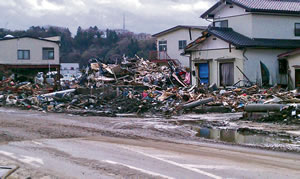Expedition Through Tsunami Debris

Tons of debris was washed into the ocean after the March 11 earthquakes and tsunami in Japan, and a lot of it is headed here. Ron Mizutani photo
I’ve always been fascinated by why people “need to know,” and I’m amazed how far some are willing to go to find answers. For some reason, our curiosity is often lured by the bizarre, the strange and, sometimes, the destructive.
The massive earthquake and crushing tsunami that struck Japan March 11 sent tons of debris into the Pacific Ocean. Scientists have tracked the floating mass as it makes it away to the west coast of the U.S. mainland. Two weeks ago, the first confirmed report of debris from Japan reached the state of Washington. Tons of debris is expected to reach Hawaii in a few years.
We’ve seen reports of scientists in the midst of this field of debris and now you can see it for yourself. Algalita Marine Research Foundation of Long Beach, Calif., and 5 Gyres Institute are offering “paying tourists” the chance to join scientists on a research cruise aboard the Sea Dragon sailing vessel.
“I hesitate to call it a ‘rubbish cruise,'” says Bill Francis, president of Algalita Marine Research Foundation. “It’s actually a scientific expedition and rather than tourists, most of the people who are participating are scientists or people very involved in ecological understanding of marine debris in our ocean.”
While scientists from China, New Zealand, Australia, Japan and the United States are expected to make up the majority of the 13-person crew, the voyage is open to anyone 18 years and older. Sailing experience is not required. Those who participate, including scientists, will assist the four-person professional crew, taking turns at watch, cooking, as well collecting samples of debris and making sure they’re stored properly.
The expedition with Pangaea Explorations will include two legs. The first is scheduled to begin May 1, 2012. The voyage begins at Kwajalein Atoll in the Marshall Islands and will make its way through an area called the “Western Garbage Patch.” The cruise is expected to reach Japan May 23, where there’ll be a week layover.
It’s the second leg that may draw the curious. Part two of the research expedition is scheduled to begin May 30 and head east to Hawaii, where scientists expect to cross the tsunami debris field. The voyage is set to end July 1 on Maui. Scientists say this isn’t about looking at garbage. They say this is a unique opportunity to learn more about what’s in the debris and how it’s affecting our precious ocean environment. They want to see how quickly or slowly debris is decomposing and how marine life may be colonizing on it.
The first leg of the tour costs $13,500. The second leg, $15,500. Deposits of $4,000 and $5,000 respectively, are required at registration. The cost includes meals and participation in scientific activities. Everyone is responsible for their own hotel stays during the layover in Japan, as well as all land transportation costs.
Organizers say participants must have personal medical insurance and a valid passport or visa.
A portion of the expedition’s cost is tax-deductible, with net proceeds benefiting Algalita Marine Research Foundation, 5 Gyres
Institute and sciencebased educational outreach.
Scientists are aware of the sensitive nature of this expedition. Personal items of those who died in the tragedy will no doubt be a part of the floating mass. This cruise is not for everyone, and space is obviously extremely limited and filling fast. The length of the expedition is also a huge commitment in time. But if you’re willing and able, this tour may be the most rewarding and fulfilling you’ll ever take.
How far would you go to find answers?
For more information on the tour, go to algalita.org/index.php to find out how you can be a part of history.



